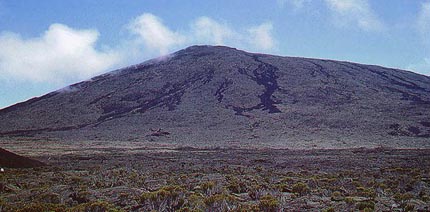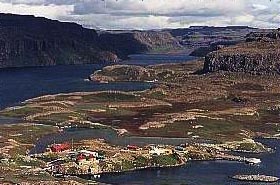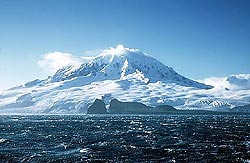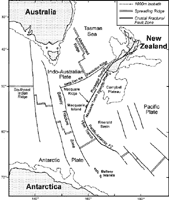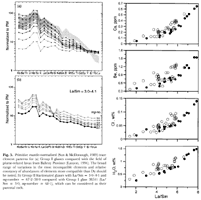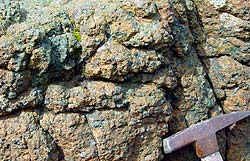Picrites, Alkali Basalt, Basanite-Phonolite Series Reunion Is. (400mi East of Madagascar)
Piton de la Fournaise The K/Rb ratio (Albarede et al 1988) averages only 321 cf.
This compares with a K/Rb of 450-2000 for MORB rocks. Some of the Reunion data show very elevated Cs. Albarede tells me Cs is very subject to alteration, though it seems regular and in keeping with the elevated Rb, Th etc. However, newer data mainly does not show this anomaly. Piton de la Fournaise has erupted 75 times over the last hundred years, the last time being in 1992. Mauritius 200 mi NE of Reunion. Alkali basalt to trachyte. No Tr. el. data Amsterdam - St Paul Two islands on the Mid Indian Ocean Rise. Both consist of a single volcano St Paul being eroded with an old caldera forming a harbour. Amsterdam (3000ft) is Recent but probably extinct with adventitious superficial cones and craters (La Grande Marmite). Both islands are plagioclase tholeiites, the only known oceanic examples. Data, (Gunn & Watkins 1975) includes some trace el. but no REE.
This is a large deeply glaciated entirely volcanic island in the southern Indian Ocean with rocks dated from 40 - 0.1 ma. Our initial data (Watkins, Gunn, Nougier & Baksi, 1974, GSAB 85, 201-212) included several hundred wet chemical analyses of perhaps not the highest accuracy for some elements, and XRF data including the common trace elements for the main types found. At Port Marie in the east, rocks were tholeiitic flood basalts becoming somewhat more alkaline in the Mont du Chateau sections and at Mon Bureau in the north. Though the latter showed some alteration and slightly erratic K & Rb, the rocks are close to Kilauean type. At de Courbet and de Galles peninsulas were alkali olivine basalts with x10 EMORB Ba-Rb, and also trachytes. Farther west were phonolites. Weiss, Frey et al (1993, E.P.S.L.18,101-19) repeated our Mon Bureau section with better data and a wider range of trace elements and confirmed the Kilauea-like composition, but their data also suffers from the effects of alteration, possibly rather more than ours which were collected by diamond drill. Their phonolite data however (see below) is excellent. The most recent activity on Kerguelen has taken place at Mt Ross in the south-west, (Weiss, & Frey et al, 1998, J.Pet., 39(5), 973-94) However these are not phonolites but trachy-basalt to trachyte and include some gabbro, and syenite exposed by glaciation. Kerguelen rocks are quite potassic, more so than Tristan da Cunha, a little less so than Gough Id in the South Atlantic and less than the Virunga Province of the African Rift, but markedly more when compared to continental phonolites of, for example Mt Erebus, and the Anatolian Province of Turkey.
Heard Id Heard lies on the Kerguelen-Gausberg Ridge and is mainly composed of a single dominant volcano, plus a few minor domes. Big Ben is a massive 9000ft alkali basalt-trachyte volcano, extinct (Maybe!) with some fumarolic activity. A large amount of XRF major element data only by Stevenson,J., (197?) is available with more recent ICPMS data included by Barling et al, 1994, (J.Pet. 35) Crozet Is East Id, (Gunn & Watkins, et al 1970, C.M & P., 28) and Possession Id (Gunn & Abransson, unpub. data) are both deeply glacially eroded with deep cross-sections. Flows range from alkali basalt to ankaramite (ol+cpx in equal amounts). Major and some trace data, no REE. This was the first ankaramite sequence found, but Beerenberg volcano in Jan Mayen now appears to also have dominant ankaramites as was found by Sven Maaloe. Marion & Prince Edward Is. These lie 750 mi. west of the Crozet group. Major and trace data, Verwoed (1990), Kable, Cherry & Erlank (1970). No REE. Comorro Is These lie between the northern tip of Madagascar and Africa. Alkali Basalts, No REE. Thompson & Flower (1971, EPScL 12) present data for Anjouan Id, D. Strong for the Kartala Centre and the la Grille lavas on Grand Comore and for Moheli Id. mainly alkali basalt - basanite with phonolites on Moheli. Dave came to our lab to do trace elements on the Comore rocks, but we did not have the ability to do REE then. Pity.
Macquarie Id Macquarie Island is entirely basaltic and lies in the subantarctic region south-west of New Zealand. Though some lava members are of undoubtedly alkaline composition (though not of low silica), it does not properly speaking belong in a discussion of alkali-basalt OIBs, being a much faulted uplifted segment of Pliocene age of the now defunct Macquarie Ridge and so belongs in the chapter on MORB's and EMORBs. However, most people would assume that it would be an alkaline OIB and would look for it here. Macquarie is a keystone in our understanding of the evolution of oceanic crust (rather than a mere voussoir), and will also discussed elsewhere at the beginning of the MORB section. A sub-Antarctic island rising to 2-3000ft, (see www.RossSea.Info ) it includes extensive pillow basalts, flows and dykes of Pliocene age, all somewhat metamorphosed, and is a typical ridge segment. Some people in fact have termed it an "ophiolite" sequence, but at least some ophiolites are of calc-alkaline affinity and the data is seldom so regular. Some early investigations had shown the presence of unusually alkaline high silica rocks, and V. Kamenetsky (2000, J.Pet. 41) proceeded to examine them in detail. Most showed many variable degrees of crystal fractionation, (mainly by ol or ol + plag) but a series rising very steeply towards a high LILE content was found to form a barrier, no glasses being found which had compositions more magnesian. It did not take Kamenetsky long to realise these could only be the untimate parental melts. They ranged from 6 to 9.5% MgO, all glasses lay to one side, all crystal cumulates on the other.
Though this has been well posted in GEOKEM since the year 2000 (now May, 2005) it is not well acepted as too many fatuous papers claiming "contamination", "Magma mixing", "Plume Influence", Layered mantle", "striped mantle", "Metasomatised mantle" etc etc have been consigned to the scrap-heap of ideas that did not prove out. Some billions of dollars are still being wasted a year by "research workers" who simply do not understand the basic causes of variation in oceanic basalt. However, as Max Planck said, "Science progresses gradually, funeral by funeral" and the non-accepting diehards, will, like Flat Earthers, Plumatasists, and Creationists, slowly vanish. Kamenetsky's finding of progressive isotope shifts with degree of melt, also consigned many thousands of papers on isotopic variations to the dust bin, and, as has happened so often in the past,his paper was rejected everywhere. Finally, after much revision and concessions to vested interests it was accepted by J.Pet. Plate-tectonics has a similar history, even after the final proof of Vine and Mathews in 1963, 20 years later many did still not believe it. Even a follow-up paper giving more proof of isotopic variations (Kamenetsky & Maas, 2002, J.Pet) appears to have been ignored. Those who have read Bill Bryson's book, "The Natural History of almost Everything" will recognise that this is not an uncommon fate of new concepts especially in Geology. In Kamenetsky et al, (2000, J.Pet.41), Dima also shows the parallelism
of mantle-normalised patterns of a series of fractionated rocks based
on those of La/Sm 3-4. These are much the same though showing a more
limited range of fractionation, as those we showed in GEOKEM for the
EPR in 1999 based on the data of Regelous et al(1999) and also those
shown for the Galapagos Rise, also in 1999 by Perfit et al (1999). We
have only recently become aware of the latter. However Kamenetsky's
chosen series are more enriched, with La/Sm of 3-4 compared to La/Sm
1.5-2 for the EPR. sets. All three data sets show increasing Sr depletion
with ol+plag fractionation and as Dima has recently pointed out from
a series collected south of the Romanche Fracture zone on the MAR, increasing
Zr/Sm due to the low Zr in plagioclase. Some Sm goes into cpx but there
is little or no good data on the Sm content of plag but La/Sm is <1. If the line of parental melts lies nearly parallel to the fractionation
trend of any two elements, correlations will always be high. If the
parental melts lie at a high angle to the fractionation trends correlations
will be poor even if a wide range of parents are all extensively fractionated,
Only when a narrow range of parent is found and fraction is extensive
will we see good correlations as in the EPR and Galapagos especially
where due to rapid spreading rates, large volume depleted parental melts
are common. That high K EMORBs existed has long been known. The Deep Sea Glass File of Melson and O'Hearn contains ( among about 1500 Pacific NMORB samples), about 40 samples showing (by about 1980) a puzzling trend of K2O rising steeply from about 9.5% MgO, much steeper than (almost at right-angles to) any fractionated series such as the EPR, Kolbeinsey Ridge, or 22N, yet though I agitated to get detailed work done on them as long as fifteen years ago, they excited no interest. Fractionated series branch to the left of this main trend of oceanic partial melts. The highest K2O as yet known in EMORBs, (indicating the lowest degree of mantle melting) is 3.25%, about double that seen in Macquarie, (1.76%) but no trace element data is available for these samples. However, the Macquarie EMORBs show a -ve K anomaly, indicating a high soda series. If the Pacific Rise samples of Melson have no such anomaly, then the maximum Nb, Cs, Rb, Ba, U, Th etc may not be much higher than we see here IF sodic rocks are more LILE enriched that potassic. The highest Nb found in the Macquarie primary unfractionated melts is 91 ppm, compared with 2.33 ppm for standard NMORB and 8.3 for standard EMORB. The most depleted NMORBs such as those from Site 504 may only have 0.25 ppm, cf 0.5 ppm in Kolbeinsey Ridge, ie less than the amount attributed to average mantle ( 0.713ppm). We can guess that for a ton of the more highly evolved melt to form, the LILE needed must be sweated out of more than 100 tons of mantle material even assuming 90% recovery. EMORBs are found in very low spreading rate areas of ridge, at the ends of spreading centres, or in failing or defunct ridges. Such conditions would allow the formation of very low degree of melt rocks. EMORBs from the Mohn's Ridge, and Knipovich Ridge have similar signatures, but are not so enriched. The interelement trends are often remarkable, eg Nb/Yb or La/Lu for both Mohn's Ridge and Macquarie Ridge EMORBs trend at right angles to the fractionated sequences seen in the EPR. The Zr/Nb ratio varies continuously (explaining the wide range in Zr/Nb in all MORB-OIB fractionates), at one extreme it is lower than for nephelinites. However, the trend for any two LILE or HFSE such as Ba/Rb, or Th/U or Co/Ni or Nb/K is almost parallel to the fractionation trend. The K/Rb ratio is remarkably low in Macquarie ranging from 333 to 210, the latter usually being found in highly evolved granites. The melt trend for K/Rb is not highly discordant as Zr/Nb is, and it is a puzzle why we see the wide range of K/Rbs (1200 - 350) in sub-oceanic basalts. The K/Rb does not quite originate at zero, and high K/Rb's can only be formed from VERY depleted parents. We can expect a burst of work world wide on such interesting end-members of the oceanic suite. The lower degree melts with their high K,(1.5-3%), high alumina, 48% silica resemble mugearites and trachybasalts but differ in their higher MgO, (6-7%) lower iron (5-7%) and much lower HFSE.
In all variation diagrams of tholeiitic MORB and OIB glasses, the Macquarie primary melt trend forms a barrier (except for high fractionates such as rhyolites) and are found on one side of the melt trend only as in a tree with branches on one side only. This barrier is not observed by alkaline series whose basic rocks follow a binary Ol-Cpx cotectic, or by the picrite series of Hawaii and Reunion, where basic rocks leave the Ol+cpx+plag eutectic and move out into the olivine field. However, the fractionation paths of the alkaline rocks are often similar to those of the tholeiitic series. Copyright © 1998-2006 Dr B.M.Gunn |
